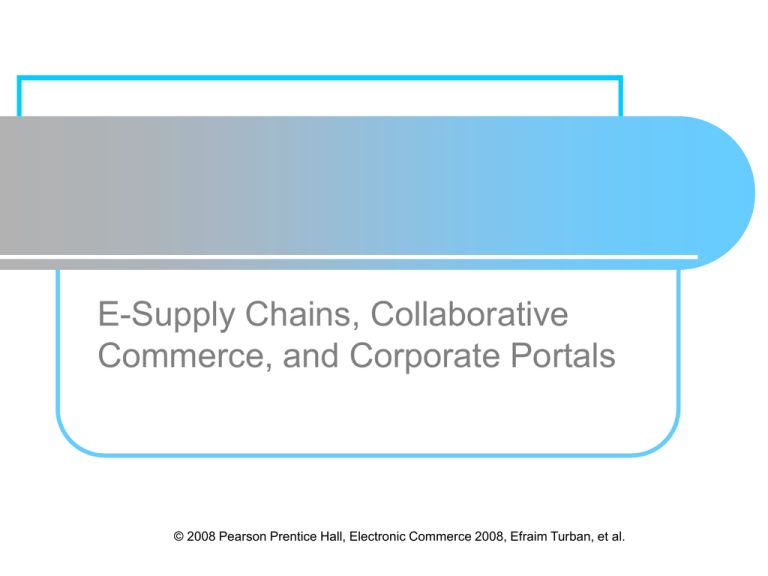
E-Supply Chains, Collaborative
Commerce, and Corporate Portals
© 2008 Pearson Prentice Hall, Electronic Commerce 2008, Efraim Turban, et al.
Learning Objectives
1. Define the e-supply chain and describe its
characteristics and components.
2. List supply chain problems and their causes.
3. List solutions to supply chain problems
provided by EC.
4. Describe RFID supply chain applications.
5. Define c-commerce and list the major types.
7-2
Learning Objectives
6. Describe collaborative planning and
Collaboration, Planning, Forecasting, and
Replenishing (CPFR) and list the benefits of
each.
7. Discuss integration along the supply chain.
8. Understand corporate portals and their types
and roles.
9. Describe e-collaboration tools such as
workflow software and groupware.
7-3
E-Supply Chains
Definitions and Concepts
supply chain
The flow of materials, information, money,
and services from raw material suppliers
through factories and warehouses to the
end customers
e-supply chain
A supply chain that is managed
electronically, usually with Web
technologies
7-4
E-Supply Chains
7-5
E-Supply Chains
Supply Chain Parts
Upstream supply chain
procurement
The process made up of a range of activities by
which an organization obtains or gains access to
the resources (materials, skills, capabilities,
facilities) they require to undertake their core
business activities
Internal supply chain
Downstream supply chain
7-6
E-Supply Chains
supply chain management (SCM)
A complex process that requires the
coordination of many activities so that the
shipment of goods and services from supplier
right through to customer is done efficiently
and effectively for all parties concerned. SCM
aims to minimize inventory levels, optimize
production and increase throughput, decrease
manufacturing time, optimize logistics and
distribution, streamline order fulfillment, and
overall reduce the costs associated with these
activities
7-7
E-Supply Chains
e-supply chain management (e-SCM)
The collaborative use of technology to improve
the operations of supply chain activities as well
as the management of supply chains
The success of an e-supply chain depends on:
The ability of all supply chain partners to view
partner collaboration as a strategic asset
A well-defined supply chain strategy
Information visibility along the entire supply chain
Speed, cost, quality, and customer service
Integrating the supply chain more tightly
7-8
E-Supply Chains
Activities and infrastructure of E-SCM
Supply chain replenishment
E-procurement
Supply chain monitoring and control using RFID
Inventory management using wireless devices
Collaborative planning
Collaborative design and product development
E-logistics
Use of B2B exchanges and supply webs
7-9
E-Supply Chains
e-procurement
The use of Web-based technology to support the key
procurement processes, including requisitioning,
sourcing, contracting, ordering, and payment. Eprocurement supports the purchase of both direct and
indirect materials and employs several Web-based
functions such as online catalogs, contracts, purchase
orders, and shipping notices
collaborative planning
A business practice that combines the business
knowledge and forecasts of multiple players along a
supply chain to improve the planning and fulfillment of
customer demand
7-10
E-Supply Chains
Infrastructure for e-SCM
Electronic Data Interchange (EDI)
Extranets
Intranets
Corporate portals
Workflow systems and tools
Groupware and other collaborative tools
7-11
E-Supply Chains
Determining the Right Supply Chain
Strategy
Functional products are staple products that have
stable and predictable demand and call for a
simple, efficient, low-cost supply chain
Innovative products tend to have higher profit
margins, volatile demand, and short product life
cycles. These products require a supply chain that
emphasizes speed, responsiveness, and flexibility
rather than low costs
7-12
Supply Chain
Problems and Solutions
Typical Problems along the Supply Chain
With increasing globalization and offshoring, supply
chains can be very long and involve many internal
and external partners located in different places
A lack of logistics infrastructure might prevent the
right goods from reaching their destinations on time
Quality problems with materials and parts also can
contribute to deficiencies in the supply chain
bullwhip effect
Erratic shifts in orders up and down supply chains
7-13
Supply Chain
Problems and Solutions
The Need for Information Sharing
along the Supply Chain
EC Solutions along the Supply Chain
Order taking
Order fulfillment
Electronic payments
Managing risk
Inventories can be minimized
Collaborative commerce
7-14
Key Enabling Supply Chain
Technologies: RFID and Rubee
radio frequency identification (RFID)
Tags that can be attached to or
embedded in objects, animals, or
humans and use radio waves to
communicate with a reader for the
purpose of uniquely identifying the object
or transmitting data and/or storing
information about the object
7-15
Key Enabling Supply Chain
Technologies: RFID and Rubee
7-16
Key Enabling Supply Chain
Technologies: RFID and Rubee
7-17
Key Enabling Supply Chain
Technologies: RFID and Rubee
7-18
Key Enabling Supply Chain
Technologies: RFID and Rubee
LIMITATIONS OF RFID
For small companies, the cost of the system may
be too high
The restriction of the environments in which RFID
tags are easily read
Different levels of read accuracy at different points
along the supply chain
Concerns over customer privacy
Agreeing on universal standards
Connecting the RFIDs with existing IT systems
7-19
Key Enabling Supply Chain
Technologies: RFID and Rubee
RuBee
Bidirectional, on-demand, peer-to-peer
radiating transceiver protocol under
development by the Institute of Electrical
and Electronics Engineers
7-20
Key Enabling Supply Chain
Technologies: RFID and Rubee
7-21
Collaborative Commerce
collaborative commerce (c-commerce)
The use of digital technologies that enable
companies to collaboratively plan, design,
develop, manage, and research products,
services, and innovative EC applications
collaboration hub
The central point of control for an e-market. A
single c-hub, representing one e-market
owner, can host multiple collaboration spaces
(c-spaces) in which trading partners use
c-enablers to exchange data with the c-hub
7-22
Collaborative Commerce
7-23
Collaborative Commerce
7-24
Collaborative Commerce
grid computing
A form of distributed computing that involves
coordinating and sharing computing, application, data,
storage, or network resources across dynamic and
geographically dispersed organizations
service-oriented architecture (SOA)
An architectural concept that defines the use of
services to support a variety of business needs. In
SOA, existing IT assets (called services) are reused
and reconnected rather than the more time consuming
and costly reinvention of new systems
7-25
Collaborative Commerce
Representative Examples of
E-Collaboration
vendor-managed inventory (VMI)
The practice of retailers’ making suppliers
responsible for determining when to order and how
much to order
Information sharing between retailers and suppliers
Retailer–supplier collaboration
Lower transportation and inventory costs and
reduced stockouts
Reduction of design cycle time
Reduction of product development time
7-26
Collaborative Commerce
7-27
Collaborative Commerce
Barriers to C-Commerce
Most organizations have achieved only
moderate levels of collaboration because of:
A lack of internal integration, standards, and
networks
Security and privacy concerns, and distrust over
who has access to and control of information
stored in a partner’s database
Internal resistance to information sharing and to
new approaches
A lack of internal skills to conduct c-commerce
7-28
Collaborative Planning, CPFR,
and Collaborative Design
collaborative planning, forecasting,
and replenishment (CPFR)
Project in which suppliers and retailers
collaborate in their planning and demand
forecasting to optimize flow of materials
along the supply chain
7-29
Collaborative Planning, CPFR,
and Collaborative Design
7-30
Collaborative Planning, CPFR,
and Collaborative Design
7-31
Collaborative Planning, CPFR,
and Collaborative Design
advanced planning and scheduling
(APS) systems
Programs that use algorithms to identify
optimal solutions to complex planning
problems that are bound by constraints
7-32
Collaborative Planning, CPFR,
and Collaborative Design
7-33
Collaborative Planning, CPFR,
and Collaborative Design
product lifecycle management (PLM)
Business strategy that enables
manufacturers to control and share
product-related data as part of product
design and development efforts
7-34
Supply Chain Integration
How Information Systems Are Integrated
Internal integration includes connecting applications
with databases and with each other and connecting
customer-facing applications (front end) with order
fulfillment and the functional information systems
(back end)
Integration with business partners connects an
organization’s systems with those of its external
business partners
7-35
Supply Chain Integration
Web Services
An architecture enabling assembly of
distributed applications from software
services and tying them together
Integration along the Extended
Supply Chain
Information integration along the extended
supply chain—all the way from raw material
to the customer’s door
7-36
Corporate (Enterprise) Portals
corporate (enterprise) portal
A gateway for entering a corporate Web
site, enabling communication,
collaboration, and access to company
information
7-37
Corporate (Enterprise) Portals
Types of Corporate Portals
Types of generic portals
Portals for suppliers and other partners
Customer portals
Employee portals
Executive and supervisor portal
mobile portals
Portals accessible via mobile devices, especially
cell phones and PDAs
7-38
Corporate (Enterprise) Portals
The Functionalities of Portals
information portals
Portals that store data and enable users to
navigate and query these data
collaborative portals
Portals that allow collaboration
7-39
Corporate (Enterprise) Portals
7-40
Corporate (Enterprise) Portals
Justifying Portals
Portals offer benefits that are difficult to
quantify
Developing Portals
Many vendors offer tools for building
corporate portals as well as hosting services
7-41
Collaboration-Enabling Tools:
From Workflow to Groupware
Workflow Technologies and Applications
workflow
The movement of information as it flows through the
sequence of steps that make up an organization’s
work procedures
workflow systems
Business process automation tools that place system
controls in the hands of user departments to
automate information processing tasks
workflow management
The automation of workflows, so that documents,
information, and tasks are passed from one
participant to the next in the steps of an
organization’s business process
7-42
Collaboration-Enabling Tools:
From Workflow to Groupware
Types of Workflow Applications
Collaborative workflow
Production workflow
Administrative workflow
The benefits of workflow management systems
include:
Cycle time reduction
Productivity gains
Improved process control
Improved quality of services
Lower staff training costs
Lower management costs
Improved user satisfaction
More effective collaboration and knowledge sharing
7-43
Collaboration-Enabling Tools:
From Workflow to Groupware
groupware
Software products that use networks to
support collaboration among groups of
people who share a common task or
goal
Synchronous versus Asynchronous
Products
7-44
Collaboration-Enabling Tools:
From Workflow to Groupware
Electronic Meeting Systems
virtual meetings
Online meetings whose members are in
different locations, even in different
countries
group decision support system (GDSS)
An interactive computer-based system that
facilitates the solution of semistructured and
unstructured problems by a group of
decision makers
7-45
Collaboration-Enabling Tools:
From Workflow to Groupware
Electronic Teleconferencing
teleconferencing
The use of electronic communication that
allows two or more people at different
locations to have a simultaneous
conference
7-46
Collaboration-Enabling Tools:
From Workflow to Groupware
video teleconference
Virtual meeting in which participants in one
location can see participants at other locations
on a large screen or a desktop computer
data conferencing
Virtual meeting in which geographicallydispersed groups work on documents together
and exchange computer files during
videoconferences
7-47
Collaboration-Enabling Tools:
From Workflow to Groupware
Voice-over-IP (VoIP)
Communication systems that transmit voice
calls over Internet Protocol–based networks
Interactive whiteboards
screen-sharing software
Software that enables group members, even in
different locations, to work on the same
document, which is shown on the PC screen
of each participant
7-48
Collaboration-Enabling Tools:
From Workflow to Groupware
Instant video
Integration and groupware suites
Lotus Notes/Domino
Microsoft NetMeeting
Novell GroupWise
7-49
Managerial Issues
1. How difficult is it to introduce ecollaboration?
2. How much can be shared with business
partners? Can they be trusted?
3. Who is in charge of our portal and intranet
content?
4. Who will design the corporate portal?
5. Should we conduct virtual meetings?
7-50



